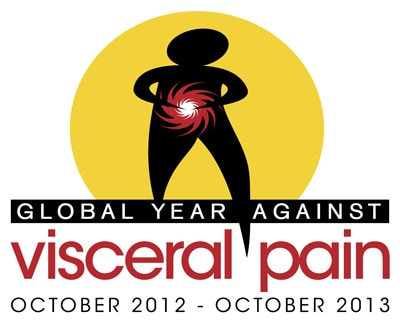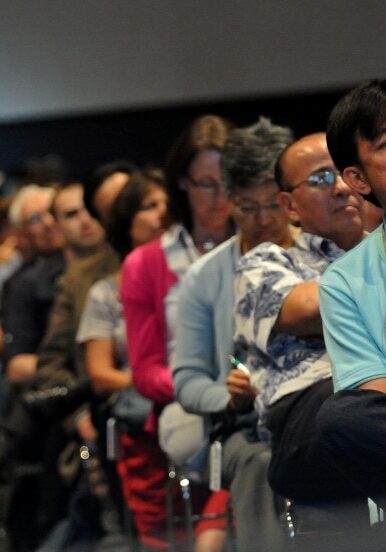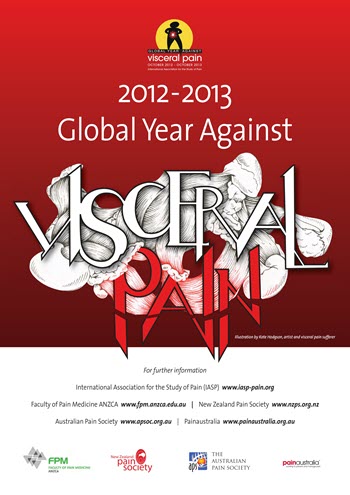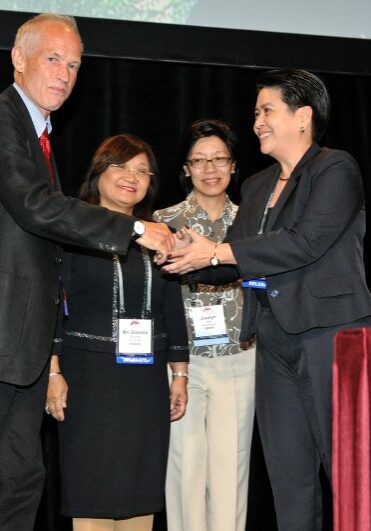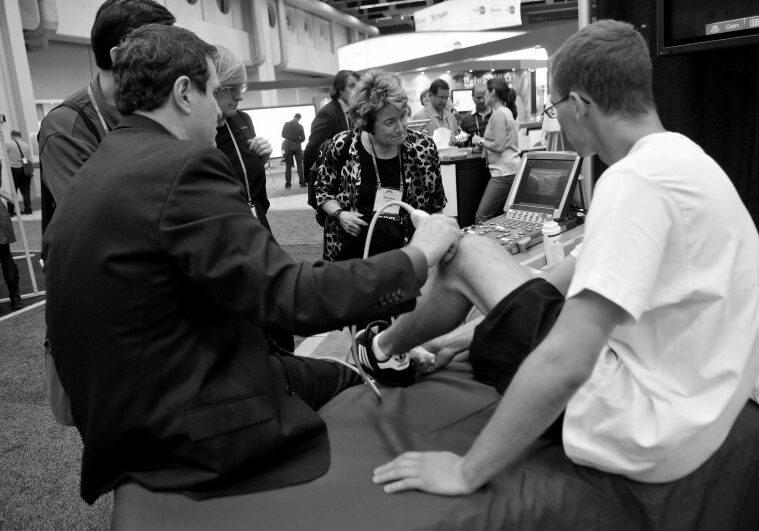Global Year Against Visceral Pain Poster
This year IASP has developed a poster for the Global Year campaign. You are welcome to use it to publicize your Global Year Against Visceral Pain-related events.
English
24 in. x 36 in. / 11 in. x 17 in. / A1 / A3
Arabic
24 in. x 36 in. / A1
Chinese
24 in. x 36 in. / A1
French
24 in. x 36 in. / A1
Polish
24 in. x 36 in. / A1 |
Portuguese (Brazil)
24 in. x 36 in. / A1
Portuguese (Portugal)
24 in. x 36 in. / A1
Spanish
24 in. x 36 in. / A1
Serbian
24 in. x 36 in. / A1
Albanian |
Note: If you would like a translated version of the Global Year logo or posters, please contact IASP.
IASP Publications Available for Download
- Global Year Event Checklist
- Functional Abdominal Pain - Pain: Clinical Updates, Volume XXI, Issue 2 (June 2013), Authors: Adam D. Farmer, Qasim Aziz
- Psychosocial Aspects of Chronic Pelvic Pain - Pain: Clinical Updates, Volume XXI, Issue 1 (June 2013), Authors: Dean A Tripp, J. Curtis Nickel
- Guide to Pain Management in Low-Resource Settings (2010) – Chapter 3: Physiology of Pain. Author: Nilesh B. Patel. Chapter 30: Dysmenorrhea, Pelvic Pain, and Endometriosis. Author: Susan Evans.
- Chronic Pelvic and Urogenital Pain Syndromes – Pain: Clinical Updates, Volume XVI, Issue 6 (September 2008). Author: Ursula Wesselmann.
- Gender, Pain, and the Brain – Pain: Clinical Updates, Volume XVI, Issue 3 (April 2008). Author: Stuart W. G. Derbyshire.
- Visceral Pain – Pain: Clinical Updates, Volume XIII, Issue 6 (December 2005). Author: Maria Adele Giamberardino.
- Why Children's Pain Matters – Pain: Clinical Updates, Volume XIII, Issue 4 (September 2005). Authors: G. Allen Finley, Linda S. Franck, Ruth E. Grunau, and Carl L. von Baeyer.
- Genetics, Pain, and Analgesia – Pain: Clinical Updates, Volume XIII, Issue 3 (September 2005). Authors: Hyungsuk Kim and Raymond A. Dionne.
- Acute Pain and Immune Impairment – Pain: Clinical Updates, Volume XIII, Issue 1 (March 2005). Author: Gayle G. Page.
- Core Curriculum for Professional Education in Pain, 3rd Edition (2005) – Part IV: Clinical States, C: Visceral Pain, Chapters 34 through 36
- Classification of Chronic Pain (1994) – Part I: Topics and Codes, F: Visceral and Other Syndromes of the Trunk Apart from Spinal and Radicular Pain; Part II: Detailed Descriptions of Pain Syndromes, B and F.
IASP Publications Available for Purchase
- Pain 2012: Refresher Courses, 14th World Congress on Pain (2012) – Part 10: Pathophysiology, Diagnosis, and Treatment of Persistent Abdominal/Pelvic Pain: Chapter 16: Chronic Abdominopelvic Pain in Women; Chapter 17: Gastrointestinal Tract Pain: Basic Science and Clinical Implications
- Pain Comorbidities: Understanding and Treating the Complex Patient (2012) – Part II: Concurrent Pain and Non-Pain Conditions, Chapter 16: Concurrent Visceral Pain Syndromes; Chapter 17: Visceral Pain and Headache in Fibromyalgia
- Fundamentals of Musculoskeletal Pain (reprint 2012) – Chapter 13: Referred Muscular Hyperalgesia from Visceral Structures
- Functional Pain Syndromes: Presentation and Pathophysiology (2009) – Part II: Visceral Pain Syndromes: Chapter 5: Irritable Bowel Syndrome and Related Disorders; Chapter 6: Sensitive Heart: A Chronic Cardiac Pain Syndrome; Chapter 7: Painful Bladder Syndrome/Interstitial Cystitis. Part IV: Neurobiological Mechanisms Contributing to Symptoms, Chapter 17: Visceral Hypersensitivity
- Proceedings of the 11th World Congress on Pain (2006) – Chapter 25: Visceral Pain and Visceral Hypersensitivity
- Pain and Suffering (1998) – Chapters 3 through 6
Other Resources
Visceral Pain – The Ins and Outs, the Ups and Downs
Shafaq Sikandar and Anthony H. Dickenson wrote a manuscript through the UK PubMed Central. The article informs readers on patients with visceral pain, the mechanisms of their pain, and their treatments. Read the journal at www.ncbi.nlm.nih.gov.
Gastrointestinal Disease: Visceral Hypersensitivity
The Medical University of South Carolina's Health Department releases several audio podcast for informational purposes. Dr. Linda Austin interviewed Dr. Mark Delegge, director of the Digestive Disease Center at MUSC, and they discussed Visceral Hypsersensitivity. Visitors may download the podcast, listen to it, and read the transcript of it at www.muschealth.com.
Informational Video
The video entitled Dr. Gary W. Jay Explains the Difference Between Somatic and Visceral Pain educates viewers about visceral pain. Dr. Jay describes somatic and visceral pain and their distinctions, and he provides examples for clarification. View the video at www.youtube.com.
Other Organizations Dedicated to Pain Research, Management, and Relief
American Association of Clinical Endocrinologists
Physicians specialized in diabetes, metabolism, and endocrinology comprise the AACE. The association, along with their college, the American College of Endocrinology, publishes a peer-reviewed journal. The AACE also includes an advocacy page on their website, hosts meetings, certifies physicians, and educates fellows-in-training. The chapters consist of a few countries, as well as several states within USA.
www.aace.com
American Association of Endocrine Surgeons
The AAES supports fellowships, hosts annual meetings, and aims to advance endocrine surgery. International leaders and American surgeons comprise the list of members in this association.
www.endocrinesurgery.org
American College of Gastroenterology
More than 12,000 physicians from 82 countries are members of the American College of Gastroenterology, whose mission is to advance the medical treatment and scientific study of gastrointestinal disorders. The College strives to serve the evolving needs of physicians in the delivery of high quality scientific, humanistic, clinical, ethical, and cost-effective health care to gastroenterology patients.
www.gi.org
American Gastroenterological Association
AGA focuses on advancing gastroenterology with research, publications, education, and information. There is a foundation and a journal within the association, and many journal articles concentrate on visceral pain.
www.gastro.org
American Heart Association
AHA publishes educational brochures and a scientific journal, and sponsors professional development seminars and scientific conferences. The association provides research training and project support.
www.heart.org/HEARTORG
American Pancreatic Association
The non-profit corporation, APA, promotes basic and clinical research concerning the pancreas. APA sponsors an annual meeting and produces a multidisciplinary, international journal.
www.american-pancreatic-association.org
Association for the Bladder Exstrophy Community
The association serves as a support group network for patients, parents, and health care providers of bladder exstrophy. ABC provides support group meetings, a forum, and a quarterly newsletter.
www.bladderexstrophy.com
Bladder and Bowel Foundation
The charity B&BF increases awareness and provides information and support regarding bladder and bowel problems.
www.bladderandbowelfoundation.org
Canadian Association of Gastroenterology
The Canadian Association of Gastroenterology (CAG) was founded in 1962 to promote the study of the digestive tract in health and disease. The Association is built on broad principles and includes individuals of different disciplines (physicians, surgeons, pediatricians, radiologists, basic scientists). CAG members are actively involved in research, education and patient care in all areas of digestive health and disease.
www.cag-acg.org
The Canadian Society of Intestinal Research
The Canadian Society of Intestinal Research (CSIR) is a registered non-profit organization dedicated to increasing public awareness, providing patient educational materials, and funding medical research regarding a broad range of gastrointestinal diseases and disorders.
www.badgut.com
Chron's & Colitis Foundation of America
The nonprofit organization thrives from its volunteer run structure and aims to cure Chron's disease and ulcerative colitis. Through research, support, and education, the organization improves the lives of patients suffering from the diseases.
www.ccfa.org
Crohn's and Colitis UK
Chron's and Colitis UK is the working name for The National Association for Colitis and Crohn's Disease (NACC), which aims to improve life for everyone affected by Inflammatory Bowel Disease (IBD), the most common forms being Crohn's Disease and Ulcerative Colitis. Together these conditions affect about 250,000 people in the United Kingdom. The charity brings together people of all ages who have been diagnosed with IBD, their families, and the health professionals involved in their care.
www.crohnsandcolitis.org.uk
IBS Network
The IBS Network is the United Kingdom's national charity for Irritable Bowel Syndrome. Its mission is to inform patients with IBS and to work with health care professionals to offer IBS support and IBS help, creating an IBS society for facilitating self-management either individually or through the agency of an IBS group.
www.theibsnetwork.org
International Federation of Gynecology and Obstetrics
The mission of FIGO is to promote the well-being of women and their children and to raise the standard of practice in obstetrics and gynecology around the world.
www.figo.org
International Painful Bladder Foundation
The IPBF provides information, publishes a newsletter, and organizes projects in order to promote awareness and knowledge of painful bladder syndrome (PBS), interstitial cystitis (IC), chronic pelvic pain syndrome (CPPS), and overactive bladder (OAB).
www.painful-bladder.org
International Foundation for Functional Gastrointestinal Disorders
International Foundation for Functional Gastrointestinal Disorders (IFFGD) is a nonprofit education and research organization dedicated to informing, assisting, and supporting people affected by gastrointestinal (GI) disorders.
www.iffgd.org
International Pelvic Pain Society
The International Pelvic Pain Society (IPPS) was incorporated to serve as a forum for professional and public education about the treatment of chronic pelvic pain.
www.pelvicpain.org
Interstitial Cystitis Association
The Interstitial Cystitis Association (ICA) is committed to finding more effective treatments and a cure for interstitial cystitis. The ICA promotes and funds research, educates the medical community and public, advocates for IC patients, healthcare providers and researchers, and offers support for IC patients and their families.
www.ichelp.org
National Fibromyalgia Association
The National Fibromyalgia Association is a 501(c) 3 nonprofit organization whose mission is to develop and execute programs dedicated to improving the quality of life for people with fibromyalgia.
www.fmaware.org
Society of Obstetricians and Gynaecologists of Canada
The mission of the Society of Obstetricians and Gynaecologists of Canada is to promote optimal women's health through leadership, collaboration, education, research and advocacy in the practice of obstetrics and gynecology.
www.sogc.org
Society for Endocrinology
The Society for Endocrinology works to improve clinical and scientific research, provide awareness, and engage high quality doctors, nurses, and scientists in the field of endocrinology. In this scope, the society publishes several journals, hosts conferences and training events, organizes many meetings, arranges a variety of informative public events, and offers a multitude of grants, awards, and prizes.
www.endocrinology.org
Vulvar Pain Foundation
The VP (Vulvar Pain) Foundation was established in 1992 as a non-profit organization to end the isolation of women suffering from vulvar pain and related disorders (fibromyalgia, interstitial cystitis, irritable bowel). The Foundation's purposes are to give reliable information, hope, safety, and success to sufferers and their families, to advance the standard of medical practice in treating vulvar pain syndrome, and to promote scientific research.
www.vulvarpainfoundation.org
